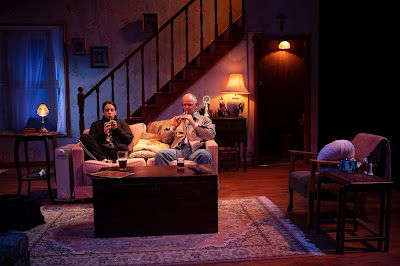 |
Presented by Belvoir, in association with Moogahlin Performing Arts at Belvoir Street Theatre Upstairs, Sydney, May 4-26, 2019. Indigenous Theatre at Belvoir is supported by The Balnaves Foundation.
Reviewed by Frank McKone
May 18
For me, a non-Indigenous unsuspecting then-teenage invader of this country in 1955, to claim that I can ‘review’ this work is not sensible. Winyanboga Yurringa is Aboriginal theatre which becomes cultural ceremony, which I can observe and respond to – but not judge. It is both Aboriginal business and specifically Aboriginal women’s business which I can respect, and participate in only through my imagination.
I have long been, through non-Indigenous law, an Australian citizen, and a bushwalker all my adult life. In her illuminating excerpt from her PhD thesis, quoted in the program, Danièle Hromek quotes Torres Strait Islander architect and artist Kevin O’Brien writing:
“Country is an Aboriginal idea. It is an idea that binds groupings of Aboriginal people to the place of their ancestors, past, current and future. It understands that every moment of the land, sea and sky, its particles, its prospects and its prompts, enables life. It is revealed over time by camping in it….There is no disenfranchisement, no censorship and no ownership. Country is a belief. It is my belief.”
Though my camping and walking on country in many parts of Australia has a history of only some 60 years – and cannot be compared with the Aboriginal history which we now know to be more like 60,000 years – my enjoyment and appreciation of ‘going bush’ means I understand the feelings of Auntie Neecy, played by Roxanne McDonald, in seeing the need to insist on the young city women camping out, even if only once a year, in the bush without their phones and alcohol.
The essence of the play is not a romance about the purity of nature (which is more like how a person of European upbringing like me might see it). For these women, it is where the realities of their lives and the conflicts which arise daily can be worked through with better understanding of how their Aboriginality literally and culturally connects them.
When the young Jada (Tuuli Narkle) rebels, steals a phone and cannot be found – since she had gone to find a spot with a mobile signal and then walked to a road to meet a boyfriend – the group, in facing the risk that she is lost and could be in harm’s way, must work together as they search. In fact, her boyfriend failed to meet her as promised. Jada returns, taught by the experience to respect the concerns of the women for her welfare, and a return to country ceremony is played out by returning items held in a museum (one woman is a PhD researcher) to be buried in the sands of this sacred site.
The crucial item is a full length possum skin cloak which they place reverently on Auntie’s shoulders in recognition of her essential role as an elder – an act of powerful emotion which connects them to the past, the present and the future.
I feel proud of the good fortune I have had at Belvoir to see again a performance by Roxanne McDonald, who I first saw in Yibiyung by Dallas Winmar (reviewed in The Canberra Times, September 2008, available at www.frankmckone2.blogspot.com ).
 |
| Angela Penrith, Tasma Walton, Roxanne McDonald, Tuuli Narkle, Dubs Yunupingu, Dalara Williams |
© Frank McKone, Canberra




























